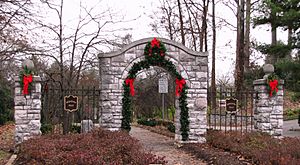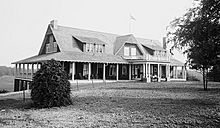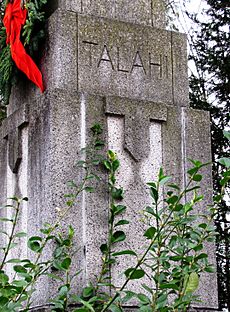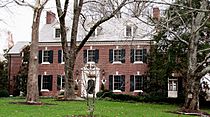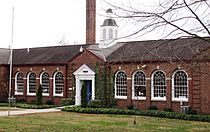Sequoyah Hills, Knoxville facts for kids
Sequoyah Hills is a special neighborhood in Knoxville, Tennessee, United States. It's located near Kingston Pike, between downtown Knoxville and the western part of the city. Sequoyah Hills was first built in the 1920s. It was one of Knoxville's first "suburbs," which are areas outside the main city. Today, many people who live here are quite wealthy. The neighborhood has many cool houses built in the middle of the 20th century. Famous architects like Charles I. Barber designed some of them. Sequoyah Hills is named after Sequoyah (around 1767–1843). He was a Cherokee scholar who invented the Cherokee alphabet.
This area was once farmland known as Looney's Bend. The modern neighborhood grew thanks to two smart business people in the 1920s: E. V. Ferrell and Robert L. Foust. Ferrell developed the Scenic Drive area. Foust created the "Talahi" subdivision near Cherokee Boulevard. Both men wanted to create perfect places where Knoxville's rich families could escape the busy city life.
Cherokee Boulevard was home to Knoxville's first Dogwood Arts Trail, which started in 1955. In 1979, the Talahi Improvements were added to the National Register of Historic Places. These are some of the early landscape designs from Foust's Talahi project.
Contents
Where is Sequoyah Hills?
Sequoyah Hills sits on a piece of land surrounded by water on three sides. This is called a peninsula. It's formed by a bend in the Tennessee River, known as Looney's Bend. The river is to the east, south, and west of the neighborhood. Kingston Pike (US-70/US-11) is to the north. Some streets just north of Kingston Pike are also part of the neighborhood association.
The area is quite hilly. There's a bluff (a steep cliff) about 10 to 15 feet high along the river's edge. From the top of this bluff, the land gently slopes up. It reaches about 40 feet (12 m) above the river. This gives many houses great views of the river and Knoxville far away.
Sequoyah Park covers most of the south side of the neighborhood. It's in the flat area between the river and the bluff. Cherokee Boulevard is a wide road with a grassy area in the middle. It curves in a U-shape around the peninsula. Another main road, Scenic Drive/Southgate Road, runs through the middle. There's a small shopping area called Council Point. It's located where Kenesaw and Keowee avenues meet.
History of Sequoyah Hills
Early Days
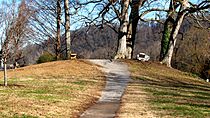
People lived in what is now Sequoyah Hills a very long time ago. Native Americans were here as early as the Woodland period (around 500–1100 A.D.). We know this because there's a 1,000-year-old Indian mound in the middle of Cherokee Boulevard. By the 1700s, the Cherokee people controlled this area. Their main towns were along the Little Tennessee River to the southwest. The neighborhood's namesake, Sequoyah, was born in a Cherokee town called Tuskegee around 1767.
In 1796, a man named Moses Looney (1750–1817) bought about 700-acre (280 ha) of land here. He and his family lived on this land for many years. That's why the area became known as "Looney's Bend." Other early landowners included James Park, who later became Knoxville's mayor. He bought land in 1804. William Lyon built a house and a mill around 1810. Drury Armstrong, who built the famous Crescent Bend house, bought land in 1846.
The oldest house still standing in Sequoyah Hills is at 715 Scenic Drive. It was built in the 1850s as a small house for workers on Allen Johnson's farm. Around 1814, George White, a relative of Knoxville founder James White, built a house on what is now Woodhill Drive. That house is gone, but you can still see parts of a barn that was with it along Scenic Drive.
How the Neighborhood Grew
In 1890, Francis Huger, a railway manager, bought over 450 acres (180 ha) in Sequoyah Hills. He wanted to move a steel mill there. But a financial crisis in 1893 stopped his plans. The land was then given to people Huger owed money to in 1908. Peter Blow, a road commissioner, built a house across the river in 1910. He ran a ferry there. Blow's Ferry Road, which connected the ferry to Kingston Pike, might have been built on an old trail.
In 1907, some Knoxville business people started the Cherokee Country Club. It was on Lyon's View Pike. They built a clubhouse on a hill with amazing views of the river and the Great Smoky Mountains. This first clubhouse was later taken down. A new building, designed by famous architects Baumann and Baumann, was built in 1928. In 1913, trolley tracks were extended to this area. This helped the neighborhood grow. Sequoyah Hills officially became part of Knoxville in 1917.
As cars became popular, rich people in Knoxville started moving out of the crowded city. They wanted bigger homes in more open areas. By 1920, several fancy houses had been built near Sequoyah Hills. In 1921, a man named S. D. Coykendall asked architects Barber & McMurry to build a house on what is now Scenic Drive.
Talahi and Sequoyah Hills Developments
In the mid-1920s, E. V. Ferrell started building many homes in Sequoyah Hills. He built Cherokee Boulevard to connect his land. He also improved Scenic Drive. Ferrell chose the name "Sequoyah Hills" to go with Cherokee Boulevard. By 1924, several houses were built on Scenic Drive. Fifty lots were sold by the end of the 1920s.
In 1926, Robert Foust bought about 100-acre (40 ha) of land in the southeast part of Looney's Bend. He planned to build a top-notch neighborhood for Knoxville. Foust wanted a place for people "who insist upon and can afford the best." He wanted to keep "all the ugliness of city life" out. He named his new subdivision "Talahi," which means "standing oak forest" in Cherokee. Foust believed this new neighborhood would mix "an Indian past, a technical future, and a natural forest setting."
Foust hired a landscape engineer named Earle S. Draper to design Talahi. The plans included curvy streets and keeping as many old trees as possible. All power lines and pipes were put underground. The lots had to be at least 5,000 square feet. Only single-family homes were allowed. Foust wanted all houses to be built in English Cottage or American Colonial Revival styles. (Later developers didn't follow this rule). He also planned for a country club by the river.
Between 1927 and 1929, Foust built several cool landscape features. These included entrance pillars, fountains, and a park (Papoose Park). Talahi opened for sales in the spring of 1929. Sadly, only one lot, at 940 Cherokee Boulevard, was sold before the stock market crashed later that year. In the early 1930s, lots in Talahi, which were first priced at $4,000 to $10,000, were selling for only $600. Foust passed away in September 1933.
Cool Buildings and Features
Quick facts for kids |
|
|
Talahi Improvements
|
|
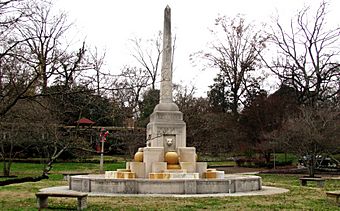
Panther Fountain
|
|
| Location | Cherokee Boulevard, Iskagna Drive, Kenesaw Avenue, Keowee Drive, Talahi Drive, Taliluna Avenue and Tugaloo Drive Knoxville, Tennessee |
|---|---|
| Area | 18 acres (7.3 ha) |
| Built | 1929 |
| NRHP reference No. | 79002447 |
| Added to NRHP | December 26, 1979 |
Talahi Improvements
Before the stock market crash in 1929, Foust finished some cool landscape features in his Talahi subdivision. These include gateposts at both ends of the subdivision along Cherokee Boulevard. There are also two fountains, a park, special streetlights, and stone benches. The roads were originally made of concrete. You can still see this concrete on parts of Talahi Drive, Iskagna Drive, and Taliluna Avenue.
The Talahi Improvements are mostly found where Talahi Drive meets Cherokee Boulevard and where Talahi Drive meets Taliluna Avenue. The two fountains, called "Sunhouse Fountain" and "Panther Fountain," are on islands in these intersections. Papoose Park, which has an iron fence around it, is in the middle of Talahi Drive between the two intersections. Stone walls with benches form a broken circle around the Cherokee Boulevard/Talahi Drive intersection.
Sunhouse Fountain is a round stone fountain with twelve small posts. Each post has a sunburst design. They used to have bronze frogs on top, but those are gone now. Panther Fountain is a round fountain with a tall stone in the middle. Water used to come out of panther heads on its four sides. The gateposts, pillars, and fountains have designs inspired by Cherokee stories and the Art Deco style.
Houses to See
- The Jenkins House on Cherokee Boulevard was built in 1955. It was designed by famous Knoxville architect Ben McMurry, Jr. In 2008, Oxford American magazine said this house was one of the best modern homes in the Southeast.
- The University of Tennessee president's house (940 Cherokee Boulevard) is a beautiful Georgian Revival-style house. It was built in the 1930s by a surgeon named Walter S. Nash. The University of Tennessee bought the house in 1960. They used it as the home for their president until 2009.
- Thomas House (715 Scenic Drive) is the oldest house still standing in Sequoyah Hills. It was built in the 1850s.
- 726 Scenic Drive is a small, one-story house built in 1948. It's a "Gunnison home," which was a type of house made in a factory after World War II.
- 934 Scenic Drive is a 2.5-story house built in 1928. It's in the Tudor Revival-style.
- 937 Scenic Drive is a two-story house built in 1924. It's in the Neoclassical-style and was designed by Barber & McMurry.
- 1029 Scenic Drive is another two-story Neoclassical-style house built in 1930, also by Barber & McMurry.
- Lockett House (1065 Scenic Drive) is a two-story Neoclassical-style house built in 1931. It was designed by Baumann and Baumann. This property also has an old log cabin that was moved from Jefferson County.
- 1079 Scenic Drive is a two-story art moderne house built in 1935.
- 1119 Scenic Drive is a 1.5-story Tudor Revival-style house built in 1940.
Other Important Buildings
- Sequoyah Elementary School The first part of this school (facing Sagwa Drive) was built in 1929. It was designed by Barber McMurry.
- Sequoyah Hills Presbyterian Church This church started in 1947. The building you see today was finished in 1954.


